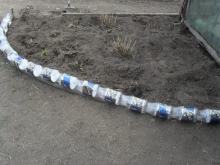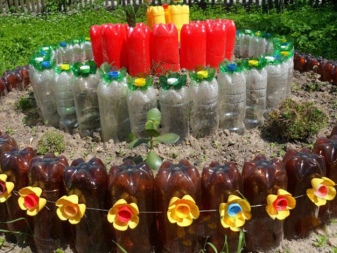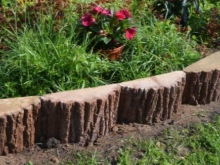We make borders for flower beds from scrap materials

Many gardeners are happy to decorate their garden using materials at hand. By limiting the flower bed with a border, the gardener thereby gives it a finished look. In this case, you need to try to keep the border neat and even. As for the framing of the tracks, they use a very different, and, it is worth noting, the material available to all. Curbs from plastic containers have gained great popularity, but there are other equally interesting and practical solutions.



Purpose of curbs
In the creation of interesting compositions in the form of a border, the owner of the site invests a lot of time and effort so that the framing gives the garden paths an attractive look. A sidewalk curb is required to delineate a walkway, making it immune to a number of problems, which often include pollution or grass overgrowth. Often, the owners of their site think not so much about the practical component of the borders, but about the aesthetic side.
Fences for paths and garden beds can be made in the same style, which will help maintain the overall style of the garden.
It is often more expedient to use ready-made options as borders, but many gardeners prefer to create them from improvised items: plastic containers, metal, wood or stone.



How to make from bottles
Many decorate flower beds with plastic bottles. If they accumulate at home - great, you don't need to get rid of them - you can easily make an attractive border from scrap materials with your own hands. In addition, in containers cut in the middle, you can also grow undersized flowers or vegetables. Plastic is used in horticulture quite often due to the properties of the material. It is durable, not afraid of water, resistant to heat, and thanks to the elasticity of the plastic, the material does not crack even in the coldest weather.
You can create a bright border for flower beds from plastic bottles. It is made in different sizes and shapes. If you want to create an eye-catching flower bed, it is recommended to collect bottles of saturated shades: red, blue, yellow. If the purpose of the curb is simply to confine space, transparent containers are fine.
The recommended volume of bottles is 3.5 liters, in addition, flowers can be planted in them. Consumables are selected depending on the size of the structure.


The flower beds are created according to personal preference. They may be:
- horizontal;
- vertical;
- multi-tiered;
- oval;
- round.


Arranging a low curb on the site allows you to zone the territory and make the garden more interesting. The whole process takes a little time - everything is done easily with your own hands from improvised means. Washed and prepared bottles are filled with sand for weighting. A shallow trench is dug along the previously marked boundaries. Bottles are installed with the neck down, half burying them. It is very important that there is no free space - this is how the border will fulfill its original function.
Note! Remember to prepare your bottles carefully. Remove labels from them, wash. Transparent bottles can be colored with acrylic paint. Paint is poured into the bottles and then shaken.

To create a track, glass bottles from any drinks are suitable. But it is worth considering that such a curb requires more careful handling to avoid injury. Before starting work, collect washed bottles of the same size. It is worth considering that to frame the track you will have to stock up on a large amount of material (about 100 bottles are needed per 1 sq. M.).
It is best to grab the curb along the edges of the path with mortar. Using twine and pegs in the work, they pre-mark the curb. Tara is leveled along the cord. The initially prepared groove is poured with cement, not reaching the edges. After a while (when the cement has set), the bottles are carefully inserted. To avoid getting the solution inside, the bottle is capped. There is another way: the bottles are alternately dug into the ground (somewhere up to half of the groove), after which a cement mass is poured along the edges of the trench.


Old tire curb
Along with plastic bottles, a border for framing a flower bed from tires is popular. They liven up the area, especially when properly decorated. Plants are usually planted inside the tires. The tire curb is laid in the ground around the perimeter or laid in a layer on the ground. Preliminary work involves the mandatory cleaning of tires from dirt, and then painting.
A great option from experienced gardeners: make a frame from metal pipes. You need to cut 3 tires, and connect the joints with staples. Paint them with bright colors, and then cover them with earth. Ready! Now you can plant beautiful flowers. Such a border will last for many years. A small border for a chamomile flower bed can be made from one whole and four tires cut in half. The petals are buried 6 cm in the ground so that they are symmetrical to the central wheel.
The composition looks more impressive in a bright version.



What else can you make
There are a lot of ideas for creating borders for flower beds - all that remains is to choose the appropriate option. Every gardener wants his plot to be attractive. This can be achieved using the materials available.
Plastic
The plastic border is an original solution, since it brings a zest to the garden, but it can also remain invisible (depending on the preferences of the gardener). Such curbs are divided into three types:
- flexible roll tape (remains almost invisible, buried in the ground) does its job perfectly well - it keeps the track, preventing it from creeping;
- sections (thanks to special individual elements, a decorative border is created);
- a ready-made fence (it has a different shape and imitates a variety of materials: for example, tiles or planks).


Metal
Metal fencing is considered the ideal solution. It comes in different shapes. The belts represent an inconspicuous fence of the path, they are buried 10 cm into the ground. The metal ribbons retain the original shape of the path and are not visible at the same time. Metal rods are used for decorative purposes: for example, forged parts of a fence can repeat paths made of metal.
The disadvantages of the design include only the price, therefore, if it is necessary to create an invisible border, gardeners often choose plastic materials.


Wood
The wood has an excellent appearance. The material is environmentally friendly, durable and easy to install. The good thing about wood is that it can be used in different ways: in the form of bars, saw cuts, boards or pegs. A wood border does its job perfectly, but it has a significant disadvantage - fragility. Before installation, the tree must be treated with protective substances.
As for the installation, it requires very little effort: first, a trench is created, then a drainage cushion is made, and at the end a material with waterproofing properties is spread.



Driftwood
An interesting solution for decorating flower beds can be driftwood. They are great for areas where there are wooden benches, carvings and window frames. Fancy driftwood must be cleaned of bark and subsequently treated with an antiseptic. As a rule, they are placed around the perimeter, after which the plants are planted.
Driftwood brings interesting motives into the landscape: the fantasy composition resembles a fairy-tale world.


Bamboo
Ecodesign in Japanese and Chinese styles is very popular now. Miniature hedges made of exotic bamboo look great on the site. They attract attention not only for their appearance, but also for their durability. Bamboo is weather resistant and light in weight. Bamboo trunks are widely used by designers in their works, creating truly magnificent compositions.


Having learned about the different ways of framing paths and flower beds, you can choose the option that suits you. Do not be afraid to experiment, create a unique border, and let the neighbors in the suburban area envy you!
When choosing a material for a border, do not forget to take into account the climatic conditions of your region, the general style of the garden. Also, don't forget that many materials require processing.

For information on how to make fences for flower beds with your own hands, see the next video.



































































The comment was sent successfully.